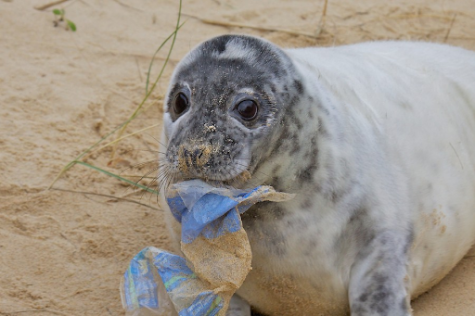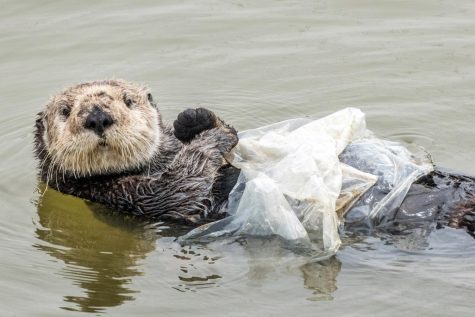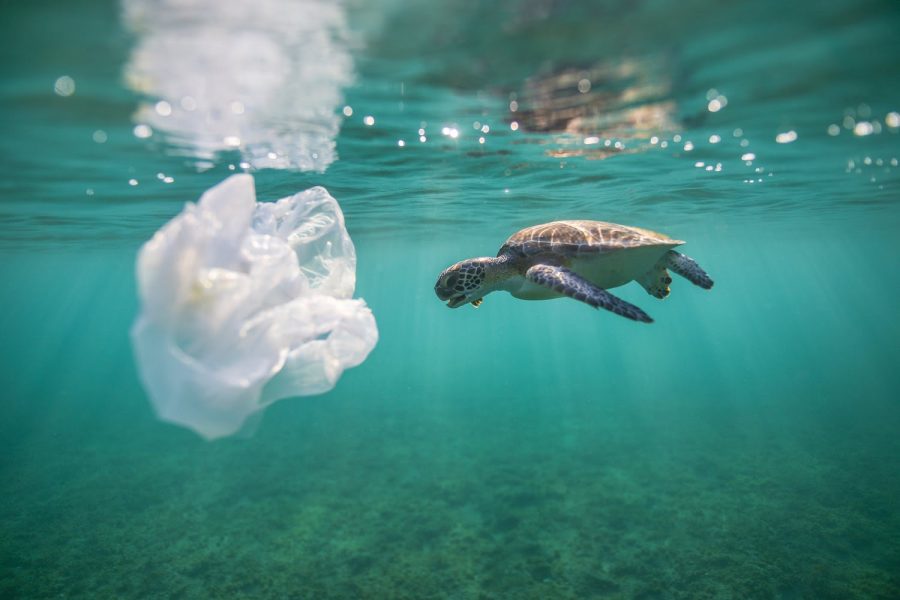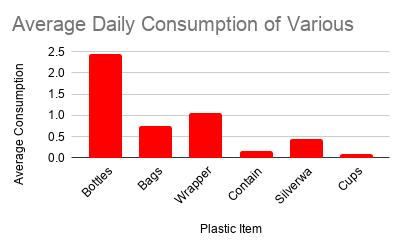Saint Joe’s Plastic Use and Possible Solutions
March 28, 2021
The introduction of plastic into humanity’s daily lives was seen as a major breakthrough. A material that is durable, cheap to produce, and could be used for almost any use was revolutionary. But while it was game-changing for humans, it was quite the opposite for our planet. Plastic has been severely polluting the Earth and murdering Earth’s creatures, and this can be seen clearly in our oceans. According to the GAIA Movement, between sixty and eighty percent of the pollution in the ocean is made up of plastic, and “over 1 million marine animals (including mammals, fish, sharks, turtles, and birds) are killed each year due to plastic debris in the ocean” (GAIA). Plastic use is killing our planet; however, we at Saint Joseph High School can do something to solve that issue. Using data and research, our team has come up with three potential solutions that we can initiate right here at school. The oceans of Earth are crying for help, and we have ideas on how to help it heal.
Not only the GAIA Movement has done research into how harmful plastic is for the marine environment, as hundreds of other organizations from around the world have been looking into this issue as well. National Geographic has looked into the problems of plastic, specifically about plastic production and how it gets into our oceans in the first place. In June of 2019, Laura Parker of National Geographic wrote that, “Every year, about 8 million tons of plastic waste escapes into the oceans from coastal nations… Production increased exponentially, from 2.3 million tons in 1950 to 448 million tons by 2015. Production is expected to double by 2050” (Parker). This means that even if you do not live near an ocean, your plastic is likely going to end up there through your local rivers and streams. Humans are producing more plastic than they ever have, and it is only going to increase as time goes on.
This high amount of plastic production is causing more plastic to flow to the ocean, which is causing so much pollution and fatalities. These deaths due to plastic pollution are horrific and graphic for the marine animals, and an example of this can be seen in A Plastic Ocean. In the documentary, a deceased sea bird’s stomach is cut open, and dozens of plastic shards are found inside. These health hazards due to plastic are affecting millions of marine animals around the world, and is causing our environment to suffer severely. So many creatures are dying due to the foreign material of plastic, and the Earth does not know what to do about it.

It is clear that plastic pollution is affecting marine animals and our environment, but how much is it affecting humanity? Like the environment, plastic is causing deadly health hazards to humanity, especially to those in developing countries. In developing countries, plastic is used as a common fuel source, which can cause respiratory issues such as cancer when burned. According to the GAIA Movement, “Burning plastic and other wastes releases dangerous substances such as heavy metals, Persistent Organic Pollutants, and other toxics into the air and ash waste residues… Such pollutants contribute to the development of asthma, cancer, endocrine disruption, and the global burden of disease” (GAIA). Developing countries do not have access to efficient and safe fuel sources, so they rely on cheap and accessible plastic to burn. However, this is causing extreme health issues, and becoming a great problem for humanity.
After we tracked our daily plastic consumption for our 5-day span, we found that there were 6 major “categories” or items that were consistently seen on a daily basis, being bottles, bags, wrappers, containers, silverware sets, and cups, such as yogurt and marinara cups. We also found that, outside of these 6 types of items, no other types of plastic were consumed. As we made calculations, we found the averages to be fascinating, and more than expected. Each person in our group averaged 2.45 plastic bottles/day (whether they be water bottles, Gatorade bottles, etc.), .75 plastic bags per day (such as grocery bags), 1.05 wrappers/day (such as candy wrappers), 0.15 plastic containers per day, and .1 plastic cups/day. Finally, each individual in our group consumed .45 silverware sets/day. However, each silverware set at Saint Joseph contains 3 plastic utensils (one fork, knife, and spoon), as well as a plastic wrapper, adding up to 4 plastic items per silverware set. After that consideration, we found that we averaged 1.35 plastic utensils per day, and .45 plastic silverware wrappers per day, which differ from the plastic wrappers previously mentioned. These numbers go to show how much plastic is used by a Saint Joseph student on a daily basis, and how we can have a significant impact on our local ecosystems and environment.
As seen in our graph titled “Average Daily Consumption of Various Plastic Items,” plastic bottles were by far the most consumed item in our daily lives, with an average of 2.45 bottles/day. The second most used option, wrappers, was only a fraction of this aforementioned average, with the following item categories being about equal to or less than one item per day per person. The data found in our group’s tracking closely aligns with international data, as plastic bottles and caps are the most commonly found plastic items along coastlines during Coastal Cleanups projects, according to Waste 360. Additionally, the other categories of plastic items used in our own daily lives were not as significant on a global scale when compared to plastic bottles, which highlights the negative environmental impact that plastic bottles have on the Earth’s environment. In conclusion, the data we found within our group was higher than we initially predicted, but nevertheless aligns with data found on a global and international scale.

To combat this problem that we have identified, we formed three unique solutions that would help to reduce the plastic usage at Saint Joe. First, a revision of the items available for purchase in the cafeteria would have a very significant impact on the amount of plastic waste we produce. To implement this solution, we will first have to conduct a full review of the items used in the school cafeteria and determine what can and should be replaced. Then, these plastic items can be replaced with more environmentally friendly alternatives one by one, working towards a more sustainable cafeteria. A great example of one thing that could be replaced is the plasticware that is used once and thrown away. Instead, silverware could take that place and cut back on the plastics being used. A second suggested improvement would be to ban the use of disposable plastic bottles and encourage the use of reusable bottles in our school. Implementing this solution would require teachers and students to cooperate while adjusting to what would be an uncomfortable change at first. After some time, though, students will get used to using water bottles and they will know not to use single-use plastic ones instead. Also, by promoting the use of and possibly selling reusable water bottles, an easy alternative can be given to the students. Lastly, our third solution is to help students become aware of the effects of plastics and reduce their usage of it. This solution is the type that will only go so far, but it would still certainly make a difference. Gathering the school for a presentation regarding the dangers of using nonrenewable plastics will educate the community about the need for change. This, in turn, will help students be more mindful and aware of their choices involving plastics, hopefully making them think twice before making a poor decision.
The revolutionary breakthrough of plastic was both a change for better and for worse. Although we use plastic for many things in our lives, the amount of plastic being used and its non-biodegradable nature has started to take a heavy toll upon the Earth and its life. In response to this, many organizations and people have started taking action. People like Craig Leeson made the documentary, A Plastic Ocean, which helps spread awareness over the aftermath of plastic that is dumped into the ocean. People are starting to use reusable water bottles over plastic ones. Some manufacturers are moving away from the use of plastic, and using other materials such as glass or silicone. Although the world has started to change, not everyone knows of the devastating effects of plastic. How much longer are we going to wait for plastic to ruin the Earth and its life?
Works Cited
Cioci, Madalyn. “The Cost and Environmental Benefits of Using Reusable Food Ware in Schools.” Minnesota Pollution Control Agency, Oct. 2014, www.pca.state.mn.us/sites/default/files/p-p2s6-16.pdf.
Estrella, Gemma. “Burning Plastic: Incineration Causes Air Pollution, Dioxin Emissions, Cost Overruns.” Global Alliance for Incinerator Alternatives, 8 Aug. 2017, www.no-burn.org/burning-plastic-incineration-causes-air-pollution-dioxin-emissions-cost-overruns.
“Information About Sea Turtles: Threats from Marine Debris – Sea Turtle Conservancy.” Sea Turtle Conservatory, 2020, www.conserveturtles.org/information-sea-turtles-threats-marine-debris.
PewTrust. “Breaking The Plastic Wave.” PewTrusts, 23 July 2020, www.pewtrusts.org/-/media/assets/2020/07/breakingtheplasticwave_report.pdf
WWF. “How Does Plastic End up in the Ocean?” WWF, 17 Apr. 2018, www.wwf.org.uk/updates/how-does-plastic-end-ocean.





